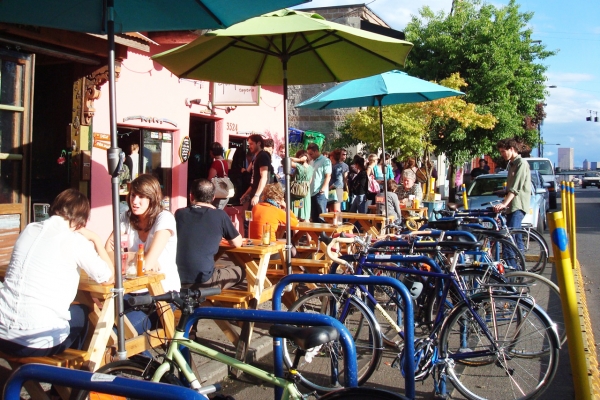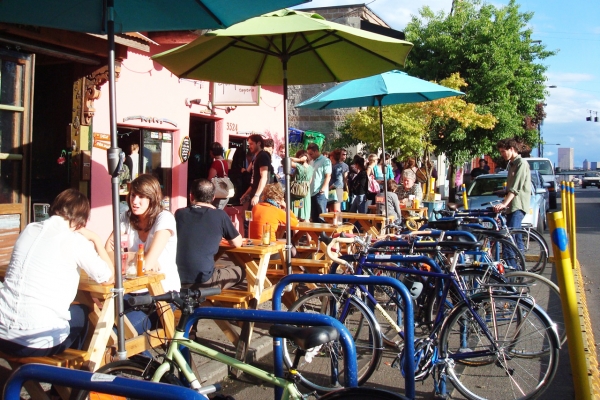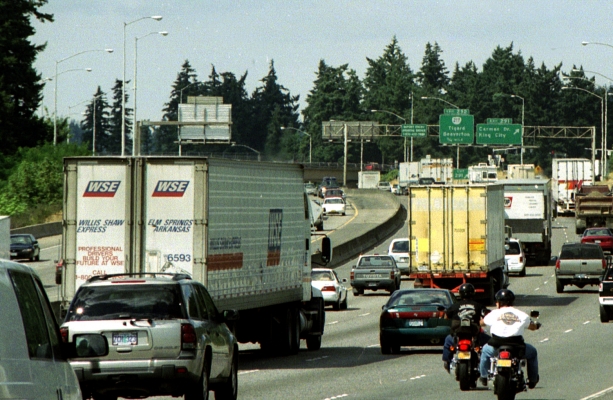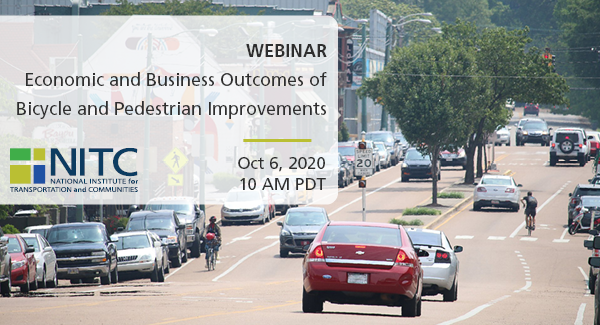Bicycle commuters represent a significant chunk of business consumers in Portland, Ore., one of America's most bike-friendly cities. OTREC research in the past year has provided data on how cyclists and other mode users patronize local businesses.
With various governments encouraging people to drive less, economists have wondered if such goals can have the side effect of harming the economy. In most cases, the answer is no, OTREC researcher B. Starr McMullen concluded in a research report.
- Click here to read more about the research and to download the report.
It’s more than an academic question: driving and the economy do tend to rise and fall together. McMullen, a transportation economics professor at Oregon State University, examined the relationship between the two by looking at which happens first—a change in driving or a change in economic activity.
In general, economic growth leads to more driving, not the other way around, McMullen said. That’s particularly true for metropolitan areas, the very places most likely to pursue policies that reduce driving.
“The more economic activity you have, the more VMT [vehicle miles traveled] you’re going to have,” McMullen said.
On the other hand, if there are policies to reduce VMT and driving decreases, “you’re not going to have the economy fall apart," as some have suggested.
If a state sets a goal to reduce VMT or transportation...
Read morePRESENTATION ARCHIVE
OVERVIEW
The National Street Improvements Study, conducted by PSU in conjunction with PeopleForBikes and consulting firm Bennett Midland, researched the economic effects of bicycle infrastructure on 14 corridors across six cities — Portland, Seattle, San Francisco, Memphis, Minneapolis and Indianapolis. The study found that improvements such as bicycle and pedestrian infrastructure had either positive or non-significant impacts on the local economy as measured through sales and employment. In this webinar, lead researcher Jenny Liu will share the results of the investigation and the unique methodology for investigating these economic outcomes.
THE RESEARCH
This webinar is based on a study funded by the National Institute for Transportation and Communities (NITC) and the Summit Foundation, and conducted at Portland State University. Read more about the research: ...
Read moreThe video begins at 2:23.
Where curb parking is free and overcrowded, many drivers cruise for a curb space rather than pay to park off-street. Research throughout the last century has shown that cruising for parking accounts for a substantial share of the t in city centers. Charging the fair market price for curb parking can elimina this cruising and all its harmful side effects. Because city governments set the prices for curb parking, they play a large part in determining whether drivers cruise. Cruising for curb parking stems from faulty public prices.
Underpriced curb parking is a perverse subsidy because it encourages drivers to congest traffic, pollute the air, and waste fuel. Cities then spend more money trying to fix the congestion and pollution problems they have created. If cities want to reduce traffic congestion, reduce air pollution, reduce energy waste, reduce greenhouse emissions, improve neighborhoods, and do this all quickly, they should charge the fair market price for curb parking and spend the resulting revenue to improve local public services. Getting the price of curb parking right will do a world of good.
Donald Shoup has extensively studied the issue of parking as a key link between transportation and land use, with important consequences for cities, the economy, and the environment. His research on employer-paid parking led to the passage of California’s parking cash-...
Read moreThe video begins at 9:25.
This paper, co-authored with Ian W.H. Parry, derives formulas for the welfare effects of reforming subsidies for peak and off-peak urban rail and bus fares, and applies them to the metropolitan areas of Washington, D.C., Los Angeles, and London. The model accounts for congestion, pollution, oil dependence, and accident externalities associated with automobiles and each transit mode. It also accounts for scale economies in transit supply, costs of accessing and waiting for transit service, crowding costs, pre-existing fuel taxes, and the transit agency’s adjustment of frequency, vehicle size, and route network in response to changes in demand. We find that in almost all cases existing subsidies – which typically exceed 50% of operating costs – are either about right, or possibly too low, across bus and rail, peak and off-peak period, in the three cities.
Speaker Biography: Kenneth A. Small, Professor Emeritus of Economics at the University of California at Irvine, specializes in urban, transportation, and environmental economics. Recent research has concentrated on urban highway congestion, measurement of value of time and reliability, effects of fuel efficiency standards, public transit pricing, and the role of fuel taxes in managing external costs of automobiles. Prof. Small served five years as coeditor of the international journal, Urban Studies, and is now Associate...
Read more



